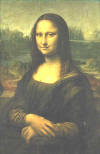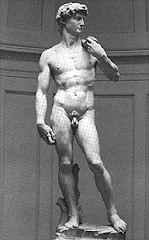
Our world has become a very visual one - we have art all around us. Understanding art is understanding our world! A good first step is to try to understand what we mean by art.
What is Art? While there is no single answer, and not everyone will agree on a definition, involving your students in a discussion of this question can be exciting, engaging, and enlightening. Both you and your students will see art in new ways after exploring the many kinds of art we have all around us.
This kind of discussion is not only an important one to have at the beginning of the school year, but one that can be brought up again more than once. It is a good introduction to an art program in general, as well as a good way to lead in to a new medium. If you are not confident with your own art knowledge, regard this kind of discussion as a learning experience for yourself as well as your students, something that you are exploring with them. You don't have to be the "expert" at everything! By learning side-by-side with your students you are modeling the curiosity and thoughtfulness you want to inspire in your classroom.
Your role as teacher will be to lead your students to discover the enormous variety of art. You will probably hold this discussion in several parts, as it will get quite lively and will take some time! Use some of the following points and questions to nudge the discussion along. See if your students can come up with some of these points themselves, and better yet, even go beyond them! And as they form their opinions, remind them that some of these questions are being debated everyday among artists!

.
The following are points and questions you can use to keep the discussion going, adapting it, of course, to your age group:
What is Art?
What are the various forms of art? When you think of art, what do you think of? Paintings & statues are common answers. (If your students use the word statues, bring up the difference between the words "statue" and "sculpture". "Statue" suggests sculpture that is realistic, usually representing the human form. "Sculpture" is a broader term, because many, like the styrofoam sculpture shown above, are abstract.) Try to elicit more forms of art, such as ceramics, printing, photography and collage.
 Is there a size limit to art? Remind your students that art can come in all sizes, from massive public art to dainty table top pieces. What are some large public pieces that the students know about? For a perspective on size, you can mention Christo's Fence, a temporary white fabric fence that undulated for miles over the Northern California hills, passing through pastures of dairy cows. This is also an example of art that was ephemeral. On the other end of the scale, the little sculpture shown below, an angel made by a four-year-old, is only five inches across.
Is there a size limit to art? Remind your students that art can come in all sizes, from massive public art to dainty table top pieces. What are some large public pieces that the students know about? For a perspective on size, you can mention Christo's Fence, a temporary white fabric fence that undulated for miles over the Northern California hills, passing through pastures of dairy cows. This is also an example of art that was ephemeral. On the other end of the scale, the little sculpture shown below, an angel made by a four-year-old, is only five inches across.
Is art defined by its materials? We're all used to thinking of paintings as art. Or bronze or marble sculptures. But art can be made from all kinds of materials. Try to think of some. Various kinds of paint and drawing mediums usually come to mind, but also ceramics, metal, wood, fabrics, plastics... it can even be an "assemblage" of junk. The assemblage shown below is one of my pieces, "The Case for Art", using an old suitcase and a pair of shoes.


A work can even combine art forms! Photography, ceramics, metalwork, collage - these can all be incorporated into a painting, or vice versa. The mixed media piece below combines drawing with a photograph taken by the young artist.
Some art moves! A piece may turn in the breeze, like the Calder mobiles. Or have a motor. They can

have sound - an artist in San Francisco even created a musical instrument that makes sounds when the ocean waves move over it. The mobile shown below, inspired by some pictures of work by both Calder and Matisse, was made with painted pieces of foam core.
Does art have to be representational? Is it necessary for it to actually look like

something, such as a woman, or a vase of flowers? Does art have to be realistic? Is it better if it is realistic? What makes it realistic? Can it be something that suggests something real, even if it doesn't look exactly like our eye sees it in real life? This wire sculpture of a face, below, was made by a fourth grader, inspired by Calder's wire sculptures.
What about abstract art? Do the students know what that means? What is abstract art about? It can suggest many things, create many moods, or simply celebrate something as basic as form or color.

You'll notice that when your students look at abstract art they tend to describe it in terms of feelings. They'll say it makes me feel happy. It makes me feel tense. Or they'll say this painting looks angry. Or quiet and peaceful. This is a wonderful way to interpret art! The white foam core sculptures below look beautiful as a group. They are completely abstract, but suggestive.

Is it art or is it literature? The piece below, done by a fourth grader, was an abstract painting to reflect a poem written by the artist about the color black.
Is it art if it illustrates words? Are the illustrations in a book art? And what if

an art piece is really a play on words? The piece shown below is my "Not a Good Drawer", referring of course to the expression kids use - good drawer - and using an actual drawer spattered with paints.
Not a Good Drawer, assemblage by Carolyn Holm"
Can art be functional? If a piece is something we use for everyday living, like a fork or a blanket, can it be art?
Are crafts art? Jewelry making, quilting, and woodworking are all referred to as crafts. Some people also call them art, while others only use the word art for certain pieces that they feel cross the line from crafts to art. Is the thing that makes the difference between craft and art the fact that it is functional? Or is the difference more about whether it is good or mediocre art, and relegating the mediocre to the craft category?
Is all art good art? Is there such a thing as mediocre art? Who decides, and how is it decided? Here's where education comes in - the more you learn about art, including doing it, the more you understand it, and the more discerning you become.
If art is used to sell something is it still art? We call this commercial art. What are some of the forms of commercial art around us? Trademarks and logos are powerful visual communicators. Other kinds of commercial art are billboards, tv ads, animation in computer games, and package design. Some of these are beautiful. Some are not. But all were created by someone for a specific commercial purpose. Is that art?
Does art have to be beautiful? What about a piece that looks truly ugly to you? Is it still art? Perhaps the artist is communicating something with that "ugliness". Sometimes the artist is trying to shock the viewer, or to make you feel uncomfortable. Why would an artist want to do that? Perhaps to make people see things in a new way?

Does it have to be painstaking to be art? Does it have to be something that takes a long time to do, and is very difficult to do? Or can a quick sketch on a napkin be a work of art?
Is it art if it is intended for another purpose? If it is originally created with the intention to instruct, or record, or illustrate, for example, is it still art? Art has always had many roles. It is thought that the beautiful hunting scenes painted in caves by prehistoric man were made as part of a ritual to assure a successful hunt. Paintings (and now photogaphy) have long been used to record how things or people look - portraits of people, landscapes and cityscapes of places. The ancient Greeks used ceramic vases to depict scenes from everyday life. Art has also long been used to tell stories or history. Religious art sets out to explain beliefs, tell a spiritual story, or simply for inspiration (think of the impact of walking into a a gothic cathedral, with its combination of soaring architecture and light filtering down through stained glass windows.) Art can be used to memorialize an event or person. The Viet Nam memorial and the Aids Quilt are two memorable examples. The round cement garden stepping stone, shown below, was created by a young child as a memorial for a dog.
Is "found art" really art? Some artists take something they simply find, and mount it and call it art. If you found an interesting piece of wood, and polished it and mounted it, would that be art? If you didn't polish it, but just mounted it, would it be art? If you just brought a piece of wood in and didn't do anything to it, didn't mount it, would this be art? Some artists will say yes, some will say no. One thing to think about is that the word art is a root in words like artifice, artifact, artisan, so linguistically it implies something made by human hands. So in that light, perhaps that piece of wood needs to have something done to it by the artist to make it art? Or is it enough that the artist selected it?
If art is something done by human hands, what is art generated on a computer? Does our definition of art include that?
What is the one thing that all these art forms have in common? All art has one defining thing that it shares with all other art - COMMUNICATION! All forms of art communicate something... a feeling, an idea, a record of fact, another way of looking at something, a statement about something wrong in our society, an appreciation of something beautiful, a spiritual understanding. Just try to think of an example of art that does not communicate anything... can you?



































